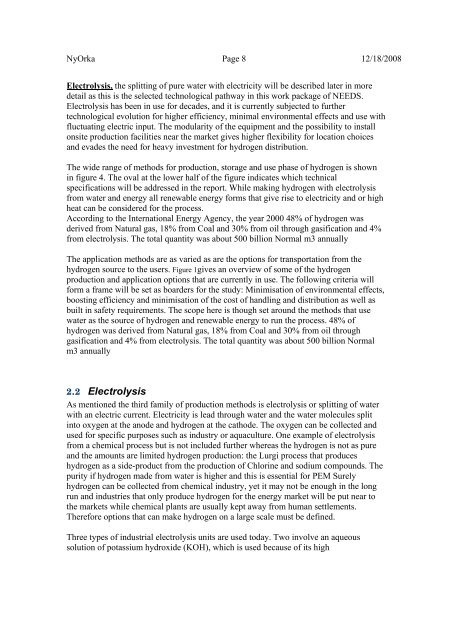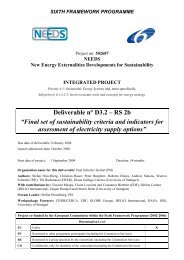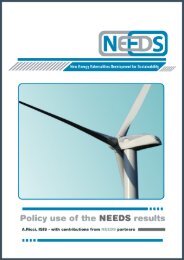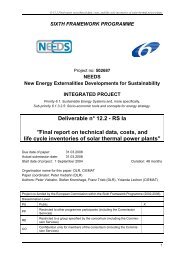Generation, of the energy carrier HYDROGEN In context ... - needs
Generation, of the energy carrier HYDROGEN In context ... - needs
Generation, of the energy carrier HYDROGEN In context ... - needs
Create successful ePaper yourself
Turn your PDF publications into a flip-book with our unique Google optimized e-Paper software.
NyOrka Page 8 12/18/2008Electrolysis, <strong>the</strong> splitting <strong>of</strong> pure water with electricity will be described later in moredetail as this is <strong>the</strong> selected technological pathway in this work package <strong>of</strong> NEEDS.Electrolysis has been in use for decades, and it is currently subjected to fur<strong>the</strong>rtechnological evolution for higher efficiency, minimal environmental effects and use withfluctuating electric input. The modularity <strong>of</strong> <strong>the</strong> equipment and <strong>the</strong> possibility to installonsite production facilities near <strong>the</strong> market gives higher flexibility for location choicesand evades <strong>the</strong> need for heavy investment for hydrogen distribution.The wide range <strong>of</strong> methods for production, storage and use phase <strong>of</strong> hydrogen is shownin figure 4. The oval at <strong>the</strong> lower half <strong>of</strong> <strong>the</strong> figure indicates which technicalspecifications will be addressed in <strong>the</strong> report. While making hydrogen with electrolysisfrom water and <strong>energy</strong> all renewable <strong>energy</strong> forms that give rise to electricity and or highheat can be considered for <strong>the</strong> process.According to <strong>the</strong> <strong>In</strong>ternational Energy Agency, <strong>the</strong> year 2000 48% <strong>of</strong> hydrogen wasderived from Natural gas, 18% from Coal and 30% from oil through gasification and 4%from electrolysis. The total quantity was about 500 billion Normal m3 annuallyThe application methods are as varied as are <strong>the</strong> options for transportation from <strong>the</strong>hydrogen source to <strong>the</strong> users. Figure 1gives an overview <strong>of</strong> some <strong>of</strong> <strong>the</strong> hydrogenproduction and application options that are currently in use. The following criteria willform a frame will be set as boarders for <strong>the</strong> study: Minimisation <strong>of</strong> environmental effects,boosting efficiency and minimisation <strong>of</strong> <strong>the</strong> cost <strong>of</strong> handling and distribution as well asbuilt in safety requirements. The scope here is though set around <strong>the</strong> methods that usewater as <strong>the</strong> source <strong>of</strong> hydrogen and renewable <strong>energy</strong> to run <strong>the</strong> process. 48% <strong>of</strong>hydrogen was derived from Natural gas, 18% from Coal and 30% from oil throughgasification and 4% from electrolysis. The total quantity was about 500 billion Normalm3 annually2.2 ElectrolysisAs mentioned <strong>the</strong> third family <strong>of</strong> production methods is electrolysis or splitting <strong>of</strong> waterwith an electric current. Electricity is lead through water and <strong>the</strong> water molecules splitinto oxygen at <strong>the</strong> anode and hydrogen at <strong>the</strong> cathode. The oxygen can be collected andused for specific purposes such as industry or aquaculture. One example <strong>of</strong> electrolysisfrom a chemical process but is not included fur<strong>the</strong>r whereas <strong>the</strong> hydrogen is not as pureand <strong>the</strong> amounts are limited hydrogen production: <strong>the</strong> Lurgi process that produceshydrogen as a side-product from <strong>the</strong> production <strong>of</strong> Chlorine and sodium compounds. Thepurity if hydrogen made from water is higher and this is essential for PEM Surelyhydrogen can be collected from chemical industry, yet it may not be enough in <strong>the</strong> longrun and industries that only produce hydrogen for <strong>the</strong> <strong>energy</strong> market will be put near to<strong>the</strong> markets while chemical plants are usually kept away from human settlements.Therefore options that can make hydrogen on a large scale must be defined.Three types <strong>of</strong> industrial electrolysis units are used today. Two involve an aqueoussolution <strong>of</strong> potassium hydroxide (KOH), which is used because <strong>of</strong> its high







